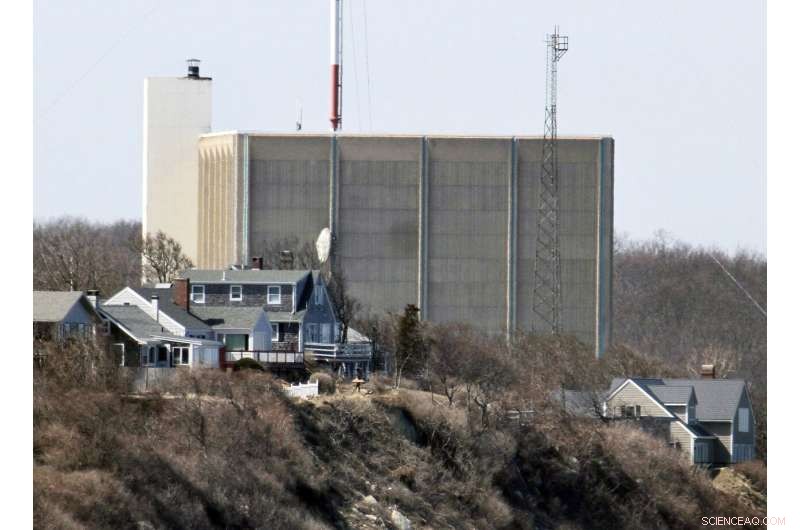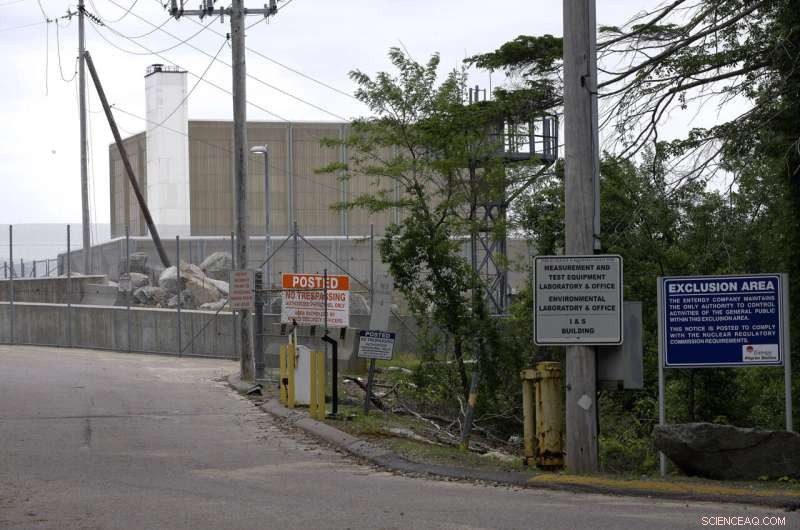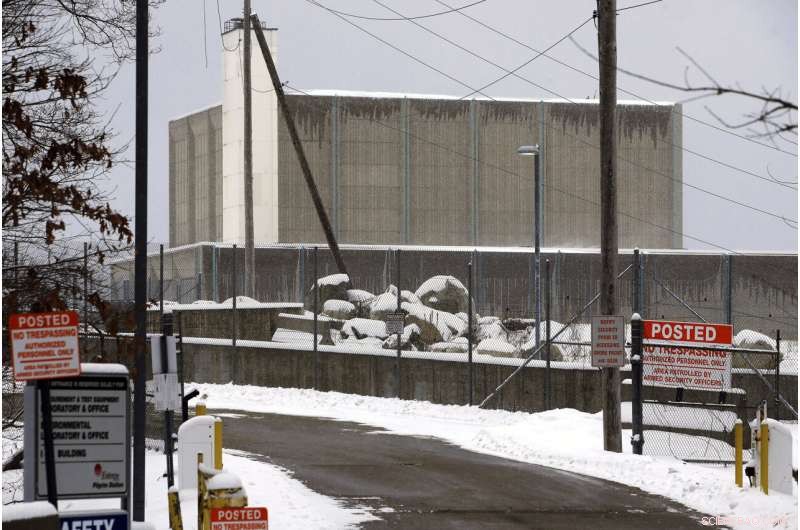
Una parte de la central nuclear de Pilgrim es visible más allá de las casas a lo largo de la costa de la bahía de Cape Cod, en Plymouth, Massachusetts, el 30 de marzo de 2011. Pilgrim, que cerró en 2019, era un reactor de agua hirviendo. El agua circulaba constantemente a través de la vasija del reactor y el combustible nuclear, convirtiéndolo en vapor para hacer girar la turbina. El agua fue enfriada y recirculada, recogiendo la contaminación radiactiva. Crédito:AP Photo/Steven Senne, Archivo
Hay un millón de galones de agua radiactiva dentro de una antigua planta de energía nuclear a lo largo de la Bahía de Cape Cod y tiene que desaparecer.
Pero, ¿dónde está la inquietante pregunta? ¿Intervendrá el Estado como lo decida la empresa que desmantela la planta?
Holtec International está considerando tratar el agua y descargarla en la bahía, lo que genera una feroz resistencia de los residentes locales, los pescadores de conchas y los políticos. Holtec también está considerando evaporar el agua contaminada o transportarla en camiones a una instalación en otro estado.
La pelea en Massachusetts refleja un acalorado debate actual en Japón sobre un plan para liberar más de 1 millón de toneladas de aguas residuales radiactivas tratadas en el océano desde la planta nuclear destrozada de Fukushima en la primavera de 2023. Un enorme tsunami en 2011 se estrelló contra la planta. Tres reactores se derritieron.
La central nuclear Pilgrim en Plymouth, Massachusetts, cerró en 2019 después de casi medio siglo proporcionando electricidad a la región. El representante estadounidense William Keating, un demócrata cuyo distrito incluye Cape Cod, escribió a Holtec junto con otros importantes legisladores de Massachusetts en enero para oponerse a la liberación de agua en la bahía de Cape Cod. Pidió a la Comisión Reguladora Nuclear de EE. UU. que examinara sus reglamentos.
Keating dijo a fines de marzo que el manejo del agua radiactiva por parte de Holtec podría sentar un precedente porque la industria de desmantelamiento de EE. UU. está en su infancia. La mayoría de las plantas nucleares de EE. UU. se construyeron entre 1970 y 1990.
"Si están escuchando, son sensibles y trabajan con estas comunidades, es importante", dijo. "Ese es el mensaje para futuros sitios de desmantelamiento".
Holtec ha adquirido plantas nucleares cerradas en todo el país como parte de su negocio de desmantelamiento, incluida la antigua estación generadora Oyster Creek en Nueva Jersey y el centro de energía Indian Point en Nueva York. Se está haciendo cargo de la planta nuclear de Palisades en el lago Michigan, que cerrará este año.
Pilgrim era un reactor de agua hirviendo. El agua circulaba constantemente a través de la vasija del reactor y el combustible nuclear, convirtiéndolo en vapor para hacer girar la turbina. El agua fue enfriada y recirculada, recogiendo la contaminación radiactiva.
Cape Cod es un punto de acceso turístico. Tener agua radiactiva en la bahía, incluso en niveles bajos, no es bueno para la comercialización, dijo el representante estatal demócrata Josh Cutler, quien representa a un distrito allí. Cutler está trabajando para aprobar legislación que prohíba la descarga de material radiactivo en aguas costeras o interiores.
Holtec dijo que Pilgrim ya descargó agua en la bahía durante 50 años mientras la planta estaba en funcionamiento y los estudios ambientales, realizados por los operadores de la planta y ahora por Holtec, han mostrado poco o ningún impacto ambiental. Los informes ambientales radiológicos se comparten con la NRC anualmente.
"Estamos trabajando para proporcionar datos científicos, educar al público sobre la realidad de la radiación en la vida cotidiana y trabajar para que los expertos expliquen la verdadera ciencia frente al miedo emocional a lo desconocido", escribió el portavoz Patrick O'Brien en un correo electrónico en marzo. .

Warning signs are posted near a gate to the Pilgrim Nuclear Power Station, in Plymouth, Mass., Tuesday, May 28, 2019. Pilgrim, which closed in 2019, was a boiling water reactor. Water constantly circulated through the reactor vessel and nuclear fuel, converting it to steam to spin the turbine. The water was cooled and recirculated, picking up radioactive contamination. Credit:AP Photo/Steven Senne, File
WHAT ARE HOLTEC'S OPTIONS?
Holtec could treat the water and discharge it in batches over multiple years, likely the least expensive option. Or, it could evaporate the water on site, as it says it has done with about 680,000 gallons (2,600 kiloliters) over the past two years.
Evaporating the water would be more challenging to do now because the spent nuclear fuel is in storage, and couldn't be used as a heat source. Holtec would have to use a different—likely more expensive—method that would release gas.
Or, Holtec could truck the water to an out-of-state facility, where it could be mixed with clay and buried or placed in an evaporation pond, or released into local waterways. That's what Keating wants.
Vermont Yankee Nuclear Power Station, another boiling water reactor, was shut down in Vernon, Vermont, in 2014. It's sending wastewater to disposal specialists in Texas and other states. Entergy operated and sold both Vermont Yankee and Pilgrim. NorthStar, a separate and competing corporation in the decommissioning business, is dismantling Vermont Yankee.
Nuclear plants occasionally need to dispose of water with low levels of radioactivity when they're operating, so a process to release it in batches into local waterways was developed early in the nuclear industry.
In recent years at Pilgrim, the two largest releases were in 2011, with 29 releases totaling about 325,000 gallons (1,500 kiloliters), and 2013, with 21 releases totaling about 310,000 gallons.
The water from those releases was well below the federal limits for the amount of radionuclides in millirems a person would be exposed to in a year if they ate local seafood or swam in nearby waters, according to the NRC.
NRC spokesperson for the Northeast Neil Sheehan said the limits are set very conservatively and are believed to be protective of the public and environment. He said it's important to consider the role of dilution—once the discharges mix with vast quantities of water any radioactivity is typically not detectable.
WHY ARE PEOPLE WORRIED?
In Duxbury, Kingston and Plymouth Bays, there are 50 oyster farms—the largest concentration in the state, worth $5.1 million last year, according to the Massachusetts Seafood Collaborative. The collaborative said dumping the water would devastate the industry, and the local economy along with it.
Diane Turco, a Harwich resident and longtime Pilgrim watchdog, questions if the water is heavily contaminated, especially from the pool that covered the stored, spent fuel for cooling and shielded workers from radiation.

A no trespassing sign is posted near the entrance to the Pilgrim Nuclear Power Station, at rear, Thursday, Feb. 28, 2019, in Plymouth, Mass. One million gallons of radioactive water is contained inside the former nuclear power plant along Cape Cod Bay. The plant's owner, Holtec International, is considering treating the water and discharging it into the bay. Local residents, shell fishermen and politicians disapprove of the plan. Credit:AP Photo/Steven Senne, File
"Isn't this a crazy idea for Holtec to use our bay as their dump? No way," she said.
Others didn't know Pilgrim's water went into the bay in previous years and they don't want it to happen again.
"We can't change that, but we can change what's happening in the future," said Cutler, the state lawmaker. "It's the first time it has ever been decommissioned, so to compare this to the past is a convenient excuse. 'Well, we did it in the past,' that sounds like my kid."
Towns on the Cape are trying to prohibit the dispersal of radioactive materials in their waters. Tribal leaders, fishermen, lobstermen and real estate agents have publicly stated their opposition as well.
Sheehan, the NRC spokesperson, said the water is not different or distinct, compared to water released during the plant's operations. Holtec would have to handle it the same way, by filtering it, putting it into a tank, analyzing the radio isotopes and calculating the environmental impacts if it was released in batches, he added.
WHO GETS THE FINAL SAY?
Holtec wouldn't need a separate approval from the NRC to discharge the water into the bay. However, Holtec would need permission from the U.S. Environmental Protection Agency if the water contained pollutants regulated by the Clean Water Act, such as dissolved metals.
If the water contained only radioactive materials regulated by the NRC, Holtec wouldn't need to ask the EPA for a permit modification, according to the EPA's water division for New England. Holtec has never given the EPA a pollutant characterization of the water associated with decommissioning, the division's director said.
Mary Lampert, of Duxbury, is on a panel created by the state to look at issues related to the Pilgrim's decommissioning. She believes the state could use its existing laws and regulations to stop the dumping and plans to press the Massachusetts attorney general to file a preliminary injunction to do so.
The attorney general's office said it's monitoring the issue and would take any Clean Water Act violations seriously.
Holtec said this week it's examining the water for possible pollutants but the lab results won't be available for awhile.
The company expects to decide what to do with the water later this year. Discharge, evaporation and some limited transportation will likely all be part of the solution, Holtec added.